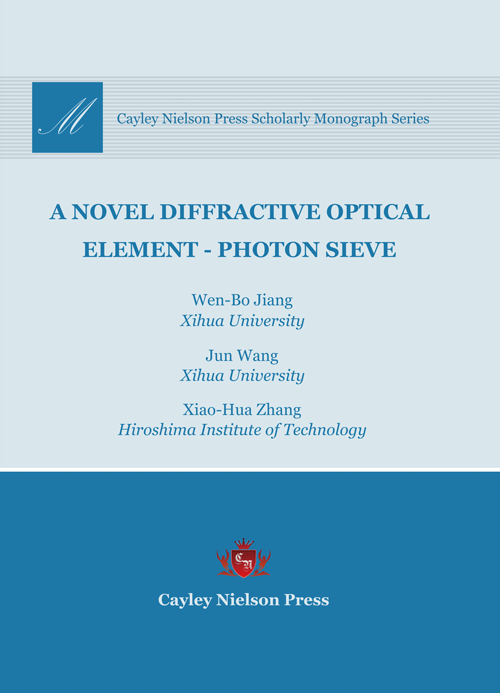
A NOVEL DIFFRACTIVE OPTICAL ELEMENT-PHOTON SIEVE

Wen-Bo Jiang
Xihua University
Jun Wang
Xihua University
Xiao-Hua Zhang
Hiroshima Institute of Technology
Copyright © 2016 by Cayley Nielson Press, Inc.
ISBN: 978-0-692-80439-1
Cayley Nielson Press Scholarly Monograph Series Book Code No.: 129-5-8
US$68.00
Preface
With the rapid development of modern optics and optoelectronic technology, great changes have taken place in optical components and optoelectronic devices. Optical components are not only including a refractive lens, a prism or a mirror, etc. Some new optical components are widely used in various optoelectronic devices, such as micro-lens array, holographic lens, diffractive optical elements, gradient index lens, etc. These new optical components become the key components of small optoelectronic device or system, which have advantages of small size, light weight, low cost and so on. Moreover, they can also make the optoelectronic device or system more compact, arraying and integrated, which can’t be easily achieved by common optical components.......
Contents
PrefAce......................................................................................................................................... I
1 Introduction..................................................................................................................... 1
1.1 The Current Research Results........................................................................ 1
1.1.1 Theoretical Results............................................................................................. 1
1.1.2 Experimental Results......................................................................................... 7
1.2 Problems.......................................................................................................................... 10
1.3 Contents of This Monograph......................................................................... 11
2 Theoretical Design.................................................................................................... 12
2.1 Introduction............................................................................................................... 12
2.2 Theoretical Model................................................................................................. 18
2.2.1 Paraxial Theoretical Model...................................................................... 18
2.2.2 Non-paraxial Theoretical Model.......................................................... 25
2.3 Different Structures.......................................................................................... 26
2.3.1 Amplitude Photon Sieve................................................................................. 26
2.3.2 Fractal Photon Sieve........................................................................................ 28
2.3.3 Dual-wavelength or Multi-wavelength Photon Sieve..... 30
2.3.4 Compound Photon Sieve.................................................................................. 33
2.4 Design Example........................................................................................................... 34
2.4.1 Design Theory.......................................................................................................... 34
2.4.2 Design Steps............................................................................................................... 35
2.4.3 Parameter Calculations................................................................................ 38
2.4.4 Numerical Simulation Results.................................................................. 40
2.5 Brief Summary............................................................................................................. 40
3 Fabrication Process................................................................................................... 41
3.1 Introduction............................................................................................................... 41
3.2 Optical Lithography............................................................................................. 42
3.3 E-beam Lithography............................................................................................... 43
3.3.1 Reversed Image Etching Process............................................................. 45
3.3.2 Direct Wet Etching Process........................................................................ 47
3.3.3 Direct Dry Etching Process.......................................................................... 49
3.3.4 Lift-off Process..................................................................................................... 51
3.3.5 Discussions.................................................................................................................. 54
3.4 Hybrid Fabrication Method............................................................................ 55
3.4.1 Fabrication Process........................................................................................... 55
3.4.1.1 E-beam Lithography Process................................................................... 56
3.4.1.2 X-ray Lithography Process....................................................................... 57
3.4.1.3 Micro-electroplating Process............................................................. 59
3.4.2 Experimental Results...................................................................................... 60
3.4.3 Discussions.................................................................................................................. 61
3.5 Brief Summary............................................................................................................. 62
4 Properties Testing..................................................................................................... 63
4.1 Introduction............................................................................................................... 63
4.2 Numerical Simulations........................................................................................ 64
4.2.1 Polarization Performance.......................................................................... 64
4.2.1.1 Vector Diffractive Model......................................................................... 64
4.2.1.2 Numerical Simulations................................................................................ 67
4.2.1.3 Discussions.............................................................................................................. 69
4.2.2 Dispersion Performance................................................................................ 71
4.2.2.1 Achromatic Theory......................................................................................... 71
4.2.2.2 Design Process..................................................................................................... 74
4.2.2.3 Numerical Simulations................................................................................ 75
4.2.2.4 Results and Discussions............................................................................... 80
4.3 Experimental Testing.......................................................................................... 80
4.3.1 Spot Amplified Detection Method........................................................ 81
4.3.1.1 Experimental Set-up...................................................................................... 81
4.3.1.2 Experimental Results.................................................................................. 82
4.3.1.3 Error Analysis and Discussions............................................................. 84
4.3.2 Moiré Fringe Phase Detection Method.............................................. 85
4.3.2.1 Experimental Set-up...................................................................................... 85
4.3.2.2 Analysis of Key Techniques...................................................................... 87
4.3.2.3 Experimental Results.................................................................................. 91
4.3.2.4 Error Analysis and Discussions............................................................. 94
4.4 Brief Summary............................................................................................................. 95
5 Applications..................................................................................................................... 97
5.1 Lithography.................................................................................................................. 97
5.1.1 Photon Sieve Used in Lithography......................................................... 97
5.1.2 Experimental Results...................................................................................... 98
5.2 Space Telescope...................................................................................................... 100
5.2.1 Photon Sieves Used in Space Telescope........................................... 101
5.2.2 Experimental Set-up....................................................................................... 101
5.2.3 Experimental Results................................................................................... 102
5.3 Bionics............................................................................................................................. 103
5.3.1 Structure of ACEs.............................................................................................. 104
5.3.2 Design Process...................................................................................................... 105
5.3.3 Numerical Simulations................................................................................. 105
5.3.4 Results and Discussions................................................................................ 109
5.4 Brief Summary.......................................................................................................... 110
6 Conclusions and Future Works..................................................................... 111
6.1 Conclusions................................................................................................................ 111
6.2 Future Works............................................................................................................ 112
References.......................................................................................................................... 114
Readership
This book should be useful for students, scientists, engineers and professionals working in the areas of optoelectronic packaging, photonic devices, semiconductor technology, materials science, polymer science, electrical and electronics engineering. This book could be used for one semester course on adhesives for photonics packaging designed for both undergraduate and graduate engineering students.
